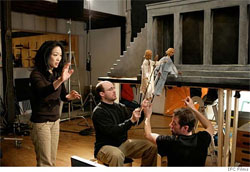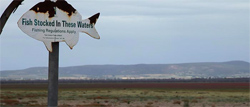Academy Award-winning director Jessica Yu’s Last Call at the Oasis opens with incredibly gorgeous pictures of water—droplets isolated to abstraction; children swimming like tadpoles through a clear pool—then cuts dramatically to a wholly different reality: images of drought, migration and desperation courtesy of the global water crisis that’s already upon us. By a filmmaker who’s dipped into a variety of genres over 20 years, from the comedy of 2007’s Ping Ping Playa, to animation with her innovative 2004 documentary profile of outsider artist Henry Darger, In the Realms of the Unreal, Last Call fascinates over the psychology underlying our collective lunatic denial to acknowledge the systemic water problem. It also recalls Yu’s psychological approach to the work of Euripides in her 2007 documentary, Protagonist, which looks at what pushes/pulls humans to obsessive extremes. Yu won her Oscar for one of her earliest films, 1996’s Breathing Lessons: The Life and Work of Mark O’Brien, about a Berkeley poet who had to use an iron lung to breathe; O’Brien’s story was the starting point for The Surrogate, a widely popular feature film that played Sundance in 2012. I spoke with Yu not far from where she first merged with O’Brien’s story, last week.
Keyframe: Since we’re speaking in downtown San Francisco, I wanted to ask you about your journalism background, which I believe began blocks away from here. Did you do work with Pacific News Service?
Jessica Yu: I don’t know if I was ever truly a journalist, but when I was starting out as a filmmaker I did some as a journalist and with Pacific News Service and Sandy Close. Sandy was the one who put me in touch with Mark O’Brien who was the subject of the film Breathing Lessons.
The old pollution was a river on fire. The new pollution is something you can’t even see. Whether it’s birth control pills, erectile dysfunction medicines, our bodies absorb some of them, excrete chemicals, flush them away. They go to the treatment plant, and are not removed.
—‘Last Call at the Oasis’
Keyframe: This latest project, Last Call at the Oasis, must have required a different approach to storytelling, given that it’s a topical collection of crises, and not one individual’s story. The overhead shots, animations, illustrations and dramatic score all help. What were your biggest challenges?
Yu: There were definitely challenges in terms of the ambition of the film, which was to try to get the big picture about the state of our water in terms of quality and quantity and climate change and regulation and industry. That’s a pretty tall order. The way we wanted to address it from the beginning was to tell stories, so the information is not abstract, so it’s grounded in human stakes that you can connect to. That was the main idea.
For the depiction of water, I wanted water to be a character, not in too heavy handed a way, but to have a presence throughout the film. So wherever we have water depicted in the environments of our stories, it’s present.
Keyframe: There have been a few great water documentaries in the past half decade, but none as complete as this one in terms of covering so many different issues and regions.
Yu: It’s interesting, because I was thinking about this. Probably this is why we wanted to go for the big picture. In a lot of the books that I read, there was usually a focus on one aspect of the water crisis. Maybe it was just on climate change. So we were thinking; I wanted for myself to connect those dots. Issues of politics and drought and overuse, and pollution have all existed since civilization began. I was interested in what it is that prevents us from taking action in a systemic way.
Keyframe: Didn’t water cause the fall of Mayan civilization?
Yu: Jared Diamond talks about this in his book Collapse; it’s an example of the Tragedy of the Commons. That’s bringing in the psychological element in the latter part of the film, to try to see: What does it take to get people to change behavior? We think we’re logical creatures, but of course we’re not. We’re emotional. We need to be wooed and to feel good about what we’re doing; a lot of those things that make it more complicated than just new policy.
How about a cool glass of recycled sewer water? … Bottled water has a positive image, safety and purity. Ironically people might be willing to pay for recycled water but not to drink it through the tap.
Keyframe: This seems to be the Participant Media strategy: To give viewers material they can act on….
Yu: That’s what’s different about water; it’s a little bit complicated. There are so many fronts on which we have issues; fronts on which we could do better. Most of us aren’t doing anything because it’s really not on our radar.
Keyframe: The fact sheet in your press kit has an enormous amount of information. Where are we in 10 years if we do nothing? In 20 years?
Yu: Here are a few of the examples that made me stay up at night. In the film, the man who’s studying groundwater depletion of the aquifer under the Central Valley, where one fifth of our food is grown in this country, said that aquifer could be depleted within 60 years. That floored me; I think we’re somewhat aware of the idea of water shortage, but in terms of being something with this kind of impact, that seems way down the line, a very future problem… We’re talking about that happening in a generation. That was terrifying to me.
The other one: Contamination. Lisa Jackson says this in the film—she is the chief administrator of the EPA—that one of our biggest problems is that we use over 80,000 chemicals in this country and only five are regulated by the Toxic Substances Control Act. That really stunned me and I thought that wee somehow have very little safeguard for when things go awry. And it’s hard to tell even how they go awry. That’s another one of those moments where you start to feel a little more outrage or dismay that we don’t even talk about these things.
Keyframe: What about fracking?
Yu: The scary thing about fracking, among other things, is the proliferation of fracking operations. One of the cases we look at in the film is when Erin Brockovich visits Midland, Texas, where they have contamination with hexavalent chromium, which is the same chemical that caused the pollution in the Soderbergh film Erin Brockovich. Here they’re seeing intense, intense concentrations. The suspect in this case is [a fracking operation.] It’s a classic David and Goliath story and it really points to the fact that we really need to keep these chemicals out of the system in the first place. But the odds are so stacked against a community to prove the contamination.
What I realized is how modern the dilemmas Euripides wrote about still are. So I was seeing these patterns of behavior. I had this idea of trying to weave together four seemingly unrelated stories. These four men in ‘The Protagonist’; you wouldn’t think they had anything in common: A former bank robber, an ex ex-gay priest, a former martial arts fanatic and an ex terrorist.
But what we are talking about in a lot of these contamination cases are not municipalities. If you’re in an urban center, city water municipalities, that water is tested on a regular basis. Chances are you’re just fine. This was one of the tricky turns in the film: Yes, we have a lot of contamination threats that we’re not monitoring; we’re not managing our resource the way we should. But that doesn’t mean we should all drink bottled water. The myths about bottled water are beginning to become more and more exposed.
Keyframe: Let’s talk about some of your earlier work. Your film Protagonist is equally interested in how humans don’t act in their own best interests at times.
Yu: I was actually approached to make a film about Euripides, which is not something you get offered every day. I had no idea what a film about Euripides would look like. I was reading all this Euripides and trying to work it out. What I realized is how modern the dilemmas Euripides wrote about still are. So I was seeing these patterns of behavior. I had this idea of trying to weave together four seemingly unrelated stories. These four men in the film; you wouldn’t think they had anything in common. A former bank robber, an ex ex-gay priest, a former martial arts fanatic and an ex terrorist. What the film does is lay out their lives almost like different instruments but they’re all playing the same tune. That’s intercut with pieces from Euripides’ plays. And of course there are puppets.
Keyframe: Most of your films have played Sundance. Did you see The Surrogate there this year? It’s based on the same Mark O’Brien who launched your own filmmaking career.
Yu: I had to John Hawkes when he was working on Mark’s character. I happened to be at Sundance this past year with a short. The minute I heard his voice as Mark, I just started crying. He was amazing. I felt like he was channeling Mark. I was kind of a wreck. The director got up there and he had polio himself. The first thing he said was we’d like to acknowledge this person who was so important to this film, and it’s me, and I’m weeping into a napkin. For me, it was a seminal Sundance moment. It’s so great to think that Mark’s continued to inspire.






